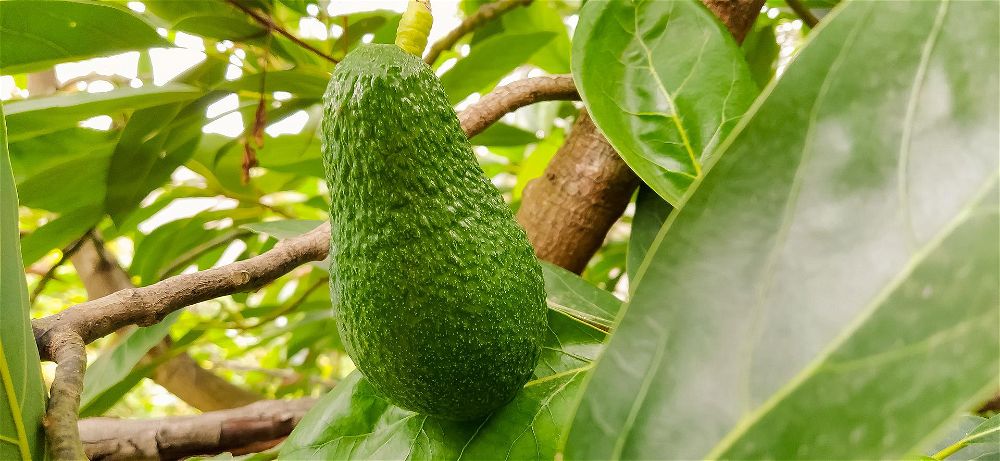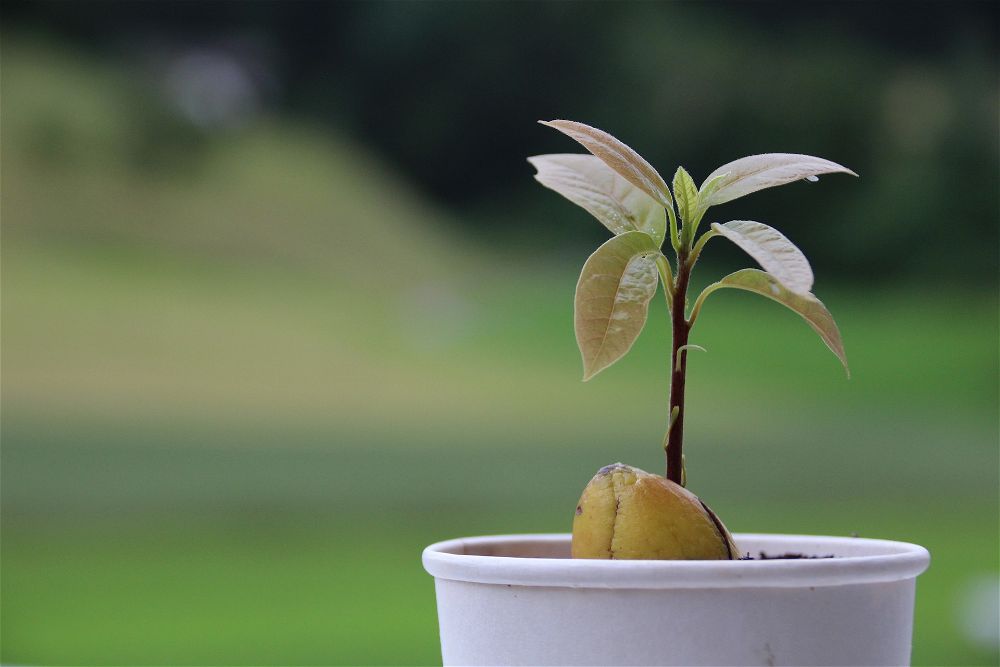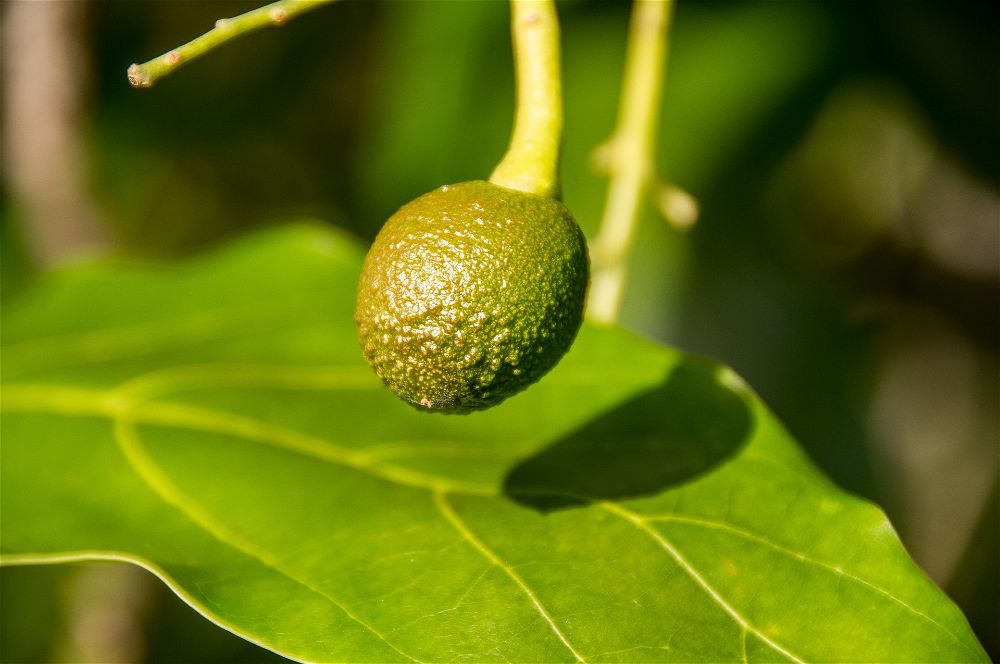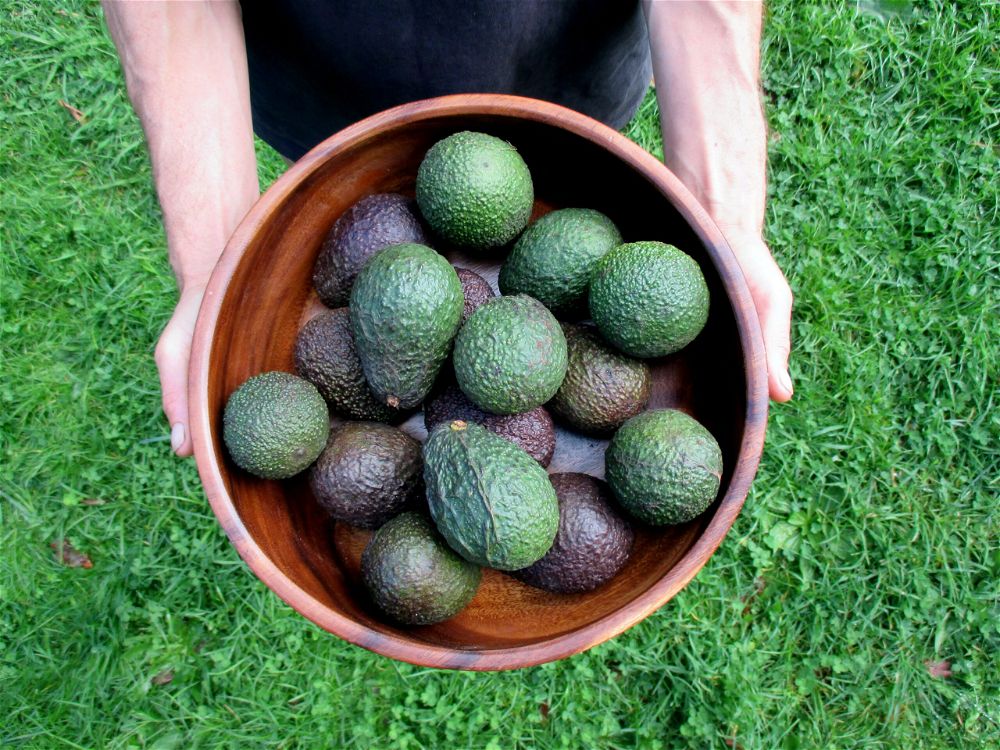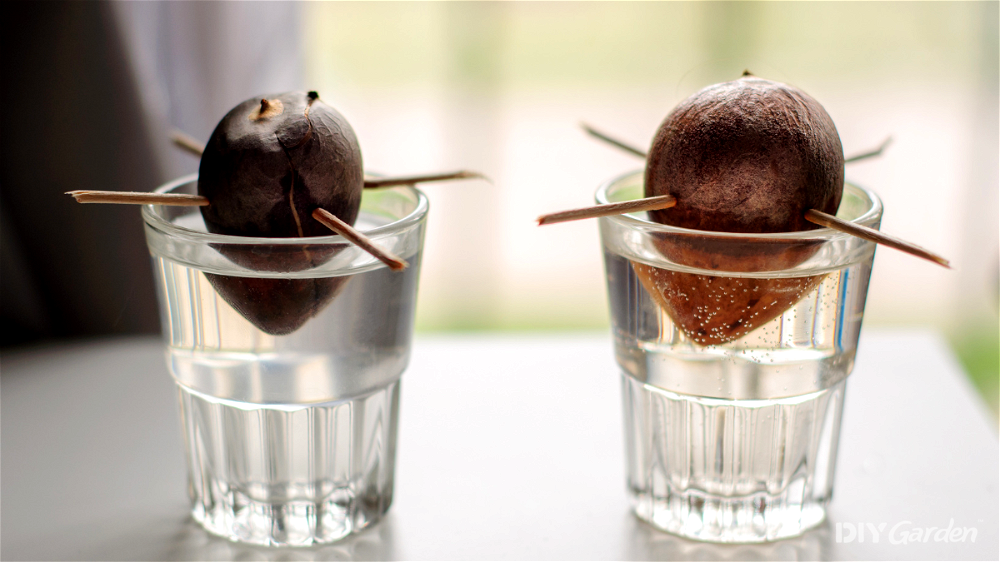
How to Grow Your Own Avocado Tree Indoors
Growing an avocado tree indoors in the UK is a fun and rewarding project, especially given the country’s cooler climate which isn’t naturally suited to tropical plants like avocados.
Here’s how you can grow an avocado tree inside your home:
1. Starting from Seed
- Extract the Seed: Carefully remove the seed from a ripe avocado without cutting into it. Wash off any remaining fruit flesh.
- Prepare for Sprouting: Insert three or four toothpicks around the circumference of the seed at its wider part. Suspend it broad end down over a glass of water, ensuring the bottom inch of the seed is submerged.
- Germination: Place the glass in a warm, bright spot but out of direct sunlight. Top up water as needed to keep the bottom submerged. Roots and a sprout should appear in 2-6 weeks.
2. Planting Your Sprout
- Potting: Once the sprout is about 15cm tall, plant it in a pot filled with well-draining potting mix. A pot with a diameter of about 20-25cm is ideal to start. Ensure the pot has drainage holes.
- Positioning the Seed: Plant the seed so that the top half sticks out of the soil. This prevents rot and encourages growth.
3. Care and Growing Conditions
- Light: Avocado trees require plenty of light. Place the pot near a south-facing window or under a grow light to ensure it gets at least 6-8 hours of sunlight daily.
- Watering: Water the plant deeply and allow the top inch of soil to dry out before watering again. Avocados do not like to be waterlogged.
- Temperature: Keep your indoor environment at a consistent temperature, ideally between 18°C to 24°C. Avoid placing your plant near cold drafts or heat sources.
4. Fertilizing
- Nutrition: Feed your avocado plant every three months with a balanced liquid fertilizer. Dilute the fertilizer to half the recommended strength to avoid overfeeding.
5. Pruning and Training
- Pruning: When your plant reaches about 30cm in height, pinch out the top two sets of leaves to encourage bushier growth. Repeat this process as it grows to shape the plant and encourage branching.
- Support: As your tree grows, it may need staking to support its weight, especially if it starts to lean.
6. Repotting
- Bigger Home: As your avocado tree grows, it will need to be repotted into larger pots. This is typically necessary every couple of years or when the roots start to circle the inside of the pot. Use a potting mix designed for citrus or palm trees, which will have the right nutrient balance and drainage.
7. Managing Expectations
- Fruit: It’s important to note that indoor avocado trees may take several years to bear fruit, and some may never produce fruit due to the lack of pollination or optimal growing conditions. However, the lush green foliage of an avocado tree can still make it a rewarding indoor plant.
8. Pests and Problems
- Pest Control: Keep an eye out for common indoor pests such as spider mites, aphids, and mealybugs. Use insecticidal soap or neem oil to manage any infestations.
- Leaf Issues: If leaves turn yellow, it could be a sign of overwatering. Let the soil dry out more between waterings. Brown tips on leaves may indicate under-watering or too much salt in the soil (from hard water or over-fertilization).
Growing Avocado Trees: A Quick Snapshot
When to Sow – Sep-Dec
When to Plant – Mar-Jun
When to Harvest – Feb-Oct
Average Yield per Plant – 200-300 avocados/year
Spacing – 2-10m
Depth – 30cm
How to Grow an Avocado Tree Indoors at Home
The reason why avocado trees are infamous for being notoriously difficult to grow is that they’re very finicky about growing conditions. Unless you live in a tropical climate, you may struggle to grow them outside. However, grow them inside and, with a little effort, you should be able to meet all of their requirements:
Warm Temperatures and Full Sun
Although different avocado varieties will each have their own level of cold tolerance, they’re all still tropical plants, meaning that they need plenty of warmth, humidity, and sunshine. This is why many choose to grow an avocado tree indoors as a houseplant – this makes it much easier to provide the tree with consistent temperatures between 15-30°C.
Some mature avocado trees can tolerate a very light and short frost. However, most of them will start to struggle if temperatures drop below 10°C.
High Humidity
Hailing from the tropics means that avocado trees require a significant amount of humidity – ideally between 60-80%. The lowest that you could potentially drop this down to would be about 40%, but the drier the environment, the more problems the tree is likely to face.
Most people have a humidity of between 30-60% in their homes, although this drops drastically in the winter, especially when indoor heating is running. To test the humidity level in your home, you can purchase a hygrometer – a small and inexpensive device. Keep in mind that various areas in your home will have differing humidity levels – for example, your bathroom will likely be much more humid than that spot in your living room next to your radiator.
Enough Room to Grow
The amount of space needed by your avocado tree will depend on the variety that you’re growing. In their natural environment, avocado trees soar to heights of over 20 metres. However, dwarf varieties are much more manageable at just 3-4 metres in height.
Pick a variety that’s suited to the amount of space that you’re able to provide. That said, keep in mind that you’ll still be able to prune your avocado tree to keep it to your desired size if it starts to really take off.
How to Grow an Avocado Tree from Seed
Since it can take anywhere between 5-13 years for an avocado tree grown from seed to produce fruit, those who are eager to start harvesting their own avocados as soon as possible will often choose to purchase trees that are a few years old instead.
However, nurturing an avocado tree from seed can still be a very rewarding and enjoyable process.
Can you use a pit from a shop-bought avocado to produce a new avocado tree? For sure, but keep in mind that most of the avocados that you see in shops are of the Hass variety, which is one of the least cold-tolerant. If you live in a cooler climate, it would be worth seeking out some seeds from a variety that’s better suited to your environment.
Once you’ve sourced your seed, follow these steps:
- Insert 3-4 toothpicks into your avocado pit. Space these evenly around the pit and have them angled slightly, so that they’re pointing downwards
- Place the avocado pit into a glass of water. The toothpicks should be balanced on the rim of the glass, so that the base of the pit (the flatter end) is touching the water but the top (the pointier end) isn’t
- Replace the water every few days – this will prevent bacteria and mould from interfering with germination
- Over the next 2-8 weeks, you’ll see the pit start to crack, with a taproot emerging from the bottom. This will be followed by a small sprout at the top of the pit
- Once the sprout grows to a 15cm long stem, cut this back to about 8cm in height
- Once the stem reaches 15cm again, your baby avocado tree is ready to be potted up
How to Plant an Avocado Tree
If you’re planting an avocado sapling, start with a 15-20cm pot. Use a loose, multi-purpose compost mixed with a small amount of sand. This helps to encourage good drainage, which is extremely important for avocado trees.
As your tree grows, continue to pot it up into larger, more suitable containers. You’ll know that it’s time to move your tree into a larger pot once you start to see roots emerging from the bottom of its current container. Your final container size will depend on the variety that you’re growing – a dwarf version will happily live its life in a smaller container, compared to a full-sized avocado tree.
On the other hand, if you’ve purchased an avocado tree that’s already a few years old, you’ll need to give it a larger pot from the start. Pick one that’s deeper than your tree’s taproot and use the same mix of multi-purpose compost and sand.
Once you’ve planted your avocado sapling/tree, give it plenty of water and then top it up with a bit more soil if needed.
How to Care for an Indoor Avocado Tree
Treat your avocado tree like an ornamental houseplant and it will reward you with plenty of lush, evergreen foliage. However, if you’re hoping to harvest fruits from your tree, you’ll need to give it a little extra care:
Watering Your Avocado Tree
Avocado trees need to be kept continuously moist, but their soil should never be over-saturated. Soggy soil can trigger a number of different problems.
An avocado tree will go through water at a much faster rate in the spring and summer, compared to the winter. This means that you’ll likely be watering your tree every couple of days during the growing season, and then once a week or so in the winter.
Feeding Your Avocado Tree
To increase the chance of your avocado tree fruiting, regularly feeding it during its growing season would be wise. You don’t need a special fertiliser for this – a balanced, water-soluble feed once a month will give your tree all of the nutrients it needs to thrive.
If your tree’s foliage starts to look yellow as your plant matures, a foliar spray containing zinc, manganese, and copper will usually correct any deficiencies.
Turning Your Avocado Tree
Ideally, your indoor avocado tree would be living in a bright and warm conservatory, where it would be receiving light from all around.
However, in reality, most people situate their indoor avocado trees on a sunny windowsill. There’s nothing wrong with this, but it does mean that your tree will only be receiving light from one side. This will affect its growth and productivity in the future, and you’ll also end up with a very unbalanced-looking tree.
To rectify this, turn your avocado tree regularly, so that all parts of the tree are able to enjoy direct sunlight at times. If your tree, or even just its foliage, starts to lean towards the light, then this is a sign that you should be turning it more regularly.
Pruning Your Indoor Avocado Tree
When left untouched, an indoor avocado tree will likely grow quite tall and spindly. Cutting it back will help to encourage more side shoots, which will give the plant a bushier and sturdier finish.
Avocado trees take well to pruning, so you can go ahead and give yours a trim a few times a year. However, never remove more than one-third of the plant at a time.
Throughout the year, you should also be removing any discolored or damaged leaves to prevent the spread of pests and diseases.
Pollinating Your Avocado Tree
Avocado trees are self-fertile, meaning that you only need one for it to produce fruit. However, in order to maximise yields, giving your tree a gentle shake every once in a while when it’s flowering will help to ensure an even spread of pollen.
How to Harvest Avocados
Unlike many other fruits, avocados don’t ripen on the tree. Instead, the ripening process only begins once the fruit has been picked. This means that you won’t end up with a huge glut of avocados – some varieties can be left on the tree for up to eight months before the fruit starts to rot. In fact, the longer an avocado is left on the tree, the higher its oil content will be, and therefore the creamier its texture.
Unfortunately, it’s not easy to tell when an avocado is ready to be picked until you’ve actually picked it. Choose your largest fruit and use some shears to snip the fruit off at its stem – never pull it away from the tree. Leave it on a counter at room temperature for a week. If the fruit softens, then this means that the avocado was ready to be picked, and chances are that your others will be the same. However, if the fruit shrivels up or remains hard and rubbery, then the others on the tree need to be left on for longer.
How to Store Avocados
Since avocados can be stored on the tree for several months, you should be able to space your harvest out quite well. If you still end up with a glut, storing the fruits in your fridge will help slow down the ripening process. However, this will also affect the flavour and texture of your fruits.
For long-term storage, freezing would be your best option. You can either freeze them whole, cut the fruits into halves or segments and then freeze, or scoop the flesh out and mash it up before freezing.
How to Prepare & Cook Avocados
There are many ways in which you could cut and peel an avocado, but this method tends to be the easiest:
- Use a sharp knife to cut the avocado in half lengthways. You’ll need to slowly rotate the fruit so that the knife runs neatly around the pit
- Open the two halves to expose the pit, which should be sitting in one half of the fruit
- Remove the pit by either scooping it out with a spoon or cutting around it so that you can pull it out
- You can now either cut your avocado into segments (before separating each segment from the peel) or scoop out the flesh with a spoon
Avocados are delicious when eaten raw – especially with a small sprinkling of lemon juice over the top. However, you could also try whipping up some of the following:
- Guacamole
- Stuffed and baked avocados
- As a spread on toast
- In a salad
- As a mayonnaise or sour cream substitute
- In a smoothie
Common Avocado Tree Problems
Although there are a number of pests and diseases that can affect avocado trees, growing your tree indoors will shelter it from many of them. That said, a couple of issues to keep an eye out for include:
- Root rot – this disease will cause an avocado tree to lose its leaves, before the entire tree wilts and dies. It’s usually caused by waterlogged conditions, so improving drainage and adjusting your watering schedule is key in preventing the disease
- Mites – this pest will leave behind a trail of yellow and black spots on the foliage as they feed. Horticultural oils are good for treating an infestation
Popular Avocado Varieties to Grow
There are three main types of avocado out there; Mexican, West Indian, and Guatemalan (although there are hundreds of hybrid varieties within each type). Mexican avocados are known for being the creamiest of them all, due to their high oil content, while the West Indian varieties have the lowest oil levels but grow to the largest size. The Guatemalan types sit somewhere in the middle.
Mexican varieties tend to be the hardiest, while West Indian types can’t tolerate even a slight frost. Again, Guatemalan varieties fall in the middle.
Which varieties are best for growing indoors? Here are a few to choose from:
- Holiday – a dwarf Guatemalan variety that has a weeping growth habit, meaning that the branches droop to form an umbrella shape
- Wertz – a Mexican and Guatemalan cross, this variety can tolerate very short and light frosts
- Gwen – another dwarf Guatemalan variety known for its high yields
- Lamb Hass – a semi-dwarf variety that produces fruits with a high oil content
Conclusion
Although it may take a few years before you’ll be able to harvest your own avocados, the wait is more than definitely worthwhile. Not only will an indoor avocado tree become more and more productive each year, but its glossy, dark green leaves will also add a beautiful tropical vibe to your home.
FAQ
How long do avocados take to grow indoors?
On average, it takes about 10 years for an avocado tree grown from seed to produce fruit. However, purchasing a tree that’s already a few years old will help to speed things up, giving you a harvest much sooner.
Can an avocado tree survive indoors?
Yes, not only can avocado trees survive indoors, but give them the right care and they’ll truly thrive. The main problem that people face is controlling the size of their indoor avocado tree, which can be avoided by growing a dwarf variety.
How do you keep an avocado tree small?
Regularly pruning your avocado tree will help to keep it at a smaller size. The pot size that you choose to use will affect how large your tree grows as well – a smaller pot will restrict the roots more, therefore limiting the tree’s size. However, use a pot that’s too small and your tree may not be able to produce fruit.
Can you cut the top off an avocado tree?
Yes, you can cut the top off an avocado tree once it reaches your desired size. This will encourage bushier growth, which will give you a healthier tree overall.
